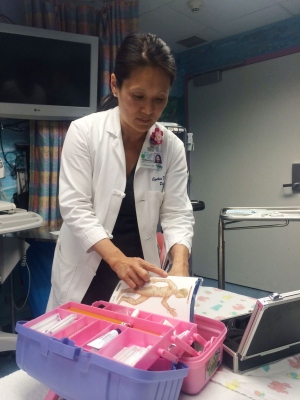Acupuncture Helps Pediatric Patients Manage Pain and Nausea
UCSF is One of Few to Academic Medical Centers to Offer Treatment to Inpatients and Outpatients

The pink plastic box that Cynthia Kim, MD, EdD, opens at the bedside of a young patient at UCSF Benioff Children’s Hospital San Francisco looks like it might contain art supplies. But inside is everything she needs to provide an ancient form of pain relief.
Kim is one of three physicians within the UCSF Department of Pediatrics trained to perform acupuncture on hospitalized patients, making UCSF one of a very few academic medical centers to offer this complementary treatment to both inpatients and outpatients.
Kim, a hospitalist specializing in pain management and palliative care, grew up in Korea where traditional Chinese medicine was the first-line treatment for family ailments. Her pediatrics training in the United States schooled her in western medicine, but Kim now offers young patients the best of both worlds.
Interested in Acupuncture?

For more information about this treatment for children, contact the Integrative Pediatric Pain and Palliative Care service at (415) 353-1328.
Kim, along with pediatric hospitalist Karen Sun, MD, and pediatric rehabilitation specialist Mitul Kapadia, MD, is a licensed medical acupuncturist – a physician trained to provide acupuncture to hospitalized patients.
Her expertise is provided through the Integrative Pediatric Pain and Palliative Care (IP3) service, which provides both traditional and complementary pain management and palliative care for children at UCSF Benioff Children’s Hospital San Francisco.
An Effective Complementary Therapy
In light of studies that have shown the benefit of this 2,000-year old treatment for conditions such as nausea, back pain, anxiety and headaches, insurance companies are increasingly covering acupuncture as a complementary treatment, said Kim.
About 3 million people in the U.S. currently use acupuncture as part of their health care, she said.

Cynthia Kim, MD, EdD, opens the pink box that contains the tools she uses to perform acupuncture on her young patients. Photo by David Law
The IP3 team provided more than 200 acupuncture consults in 2013 to hospitalized patients. Most of the patients Kim sees are undergoing cancer treatment and use acupuncture to help manage chronic nausea from chemotherapy or to relieve discomfort from other aspects of their treatment.
Acupuncture has been shown to reduce nausea by up to 70 percent, according to Kim. The treatment, which very rarely has side effects, can also help with post-surgical pain.
Controlled studies of acupuncture in pediatric patients have shown its usefulness in managing nausea after surgical removal of tonsils and adenoids and following eye surgery to correct strabismus. It has also been shown to help reduce chronic headache pain in children. Just how acupuncture works is not well understood, but it may stimulate the release of neurotransmitters such as endorphins and serotonin or otherwise inhibit pain transmission.
Acupuncture is based on the theory that energy flows along meridians, or channels, in the body, and that blockages in this flow lead to illness.
Acupuncturists memorize thousands of pressure points along major and minor meridians that are believed to affect body functions, said Kim. She often applies acupuncture to a nausea pressure point along the forearm, but points around the ear are also useful in managing the stress and anxiety that can accompany hospital treatment.
Laser Acupuncture Offers Alternative to Needles
Traditionally, acupuncture involves inserting very thin needles into the body, but there are a number of variations on classic acupuncture that are also effective, including adding electrical stimulation to the acupuncture point, or simply applying pressure.
Laser acupuncture is a particularly popular option for young children. It uses infrared light from a device that resembles a small flashlight to deliver an imperceptible dose of thermal energy to the pressure point. Research has shown laser acupuncture to be as effective as needles, said Kim, which is a boon for young patients who may become anxious at the sight of yet another needle, even one that is painless.
“They’d much rather see me use my little red light,” said Kim with a smile.
Effective acupuncture is tailored to an individual’s personality traits, so Kim typically spends a half-hour with patients during treatments to get to know them. She clearly relishes the time she spends with each child.
“Acupuncture involves touching, and that is a part of the healing process that is not emphasized in western medicine,” she said.
After evaluating a patient to see if symptoms are likely to respond to acupuncture, Kim typically administers five treatments over the course of several weeks. She then teaches parents and children how to treat these same points on their own with acupressure. About half of the children who receive treatment during their hospitalizations also use acupuncture on an outpatient basis, often through the IP3 service’s weekly clinic.
Ongoing Research
Now that acupuncture is incorporated into pediatric care at UCSF, the team plans to add to the body of research on how it can best be used.
Kim is conducting a controlled trial using laser acupuncture on young patients who undergo renal biopsies each year at the children’s hospital. The biopsy involves inserting a large needle into the kidney, a procedure that can be painful and make patients anxious.
The study is comparing actual to sham treatment by means of pre- and post-treatment patient surveys. Preliminary data suggest a 50-percent decrease in the use of pain medications and anxiety, said Kim.